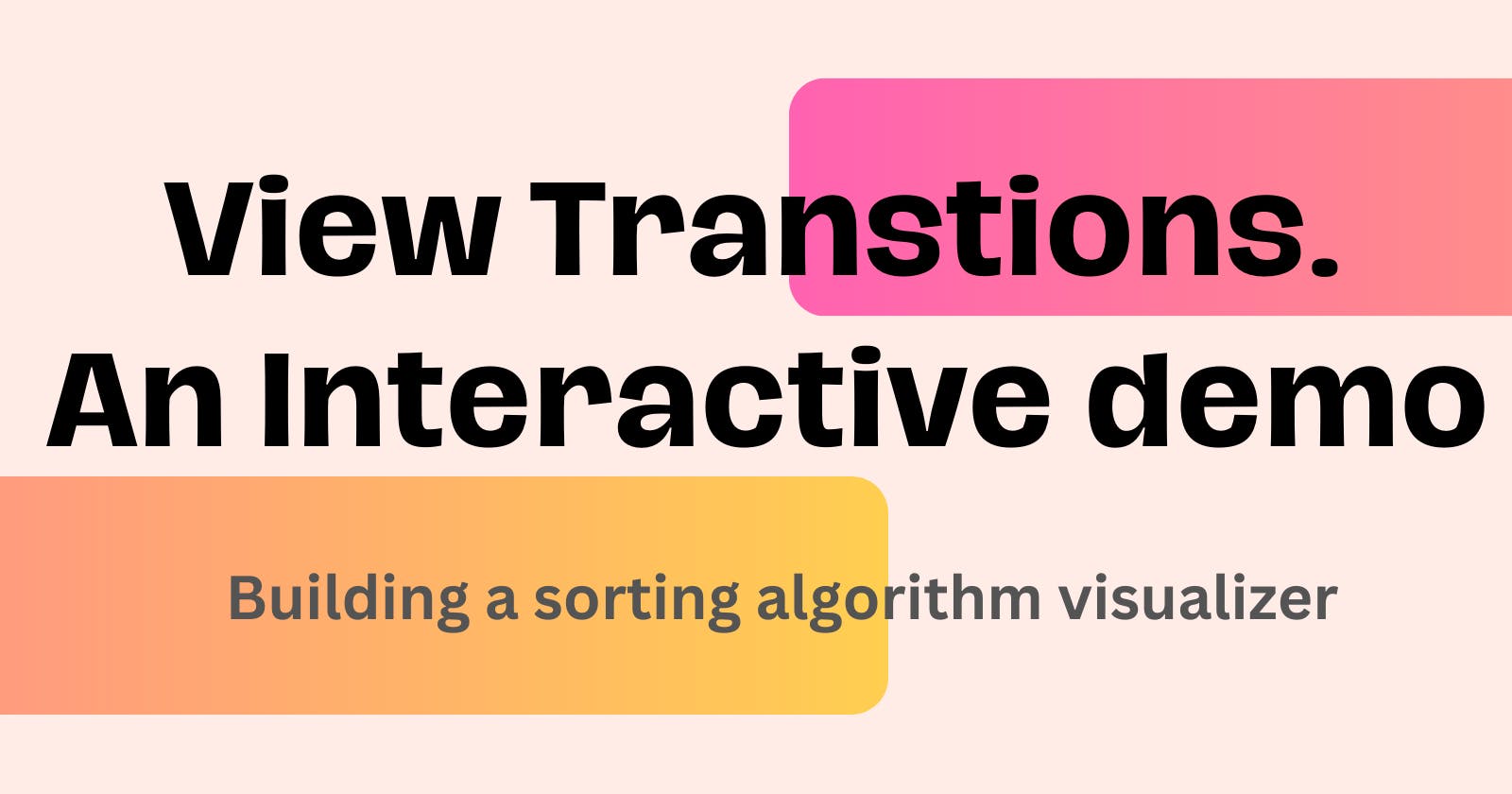Read the visually guided article on my blog here
Recently I did something I have been wanting to do for a while now, and it has honestly been stuck in my head for the past 2+ years, but I never got to implement it, up until recently.
Getting to put out the initial contents for DevCanvas (online HTML/CSS/JS editor), which I’m currently working on, gave me the motivation to experiment with creating the algorithm visualizer.
Also, It happens to be a great time for building on the web, and lots of things that manually used to be done are now been adopted natively by browsers. Which brings me to the whole point of this article - View Transitions API.
The view-transitions-api has been in the works for some while in and still in an experimental stage, but hype has only started to grow recently, which has also brought my attention to it.
What is View Transitions API
The API was introduced to solve need to transition between states. it has never been easy to perform these transitions, and often required a lot of work and verbosity, just to make the user experience a little nicer.
Setting this up by ourselves takes lots of our precious time, and often not perfect and flawed heavily in some ways. Although Svelte (my most beloved framework) has a solution for this, the view transitions once fully ready and supported will make things super easier.
Nevertheless, we are going to dive in and take a looks at how it works and how I achieved the magic of smooth transition in my sorting algorithm visualizer.
How it works
The view-transition-api has been said to capture the before and after state of a DOM, and smoothly perform the corresponding transition.
How I created the visualizer
The breakdown of the steps is as follows:
Create some kind of bars with the array
At every completed action in the sorting algorithm, replace the old bars with the new array.
This is the entire plan, and with my little knowledge of JavaScript and CSS, I don’t know how I can ever be able to animate that. Thankfully, I’m part of the luckier generation, and I have the view-transitions-api.
One super interesting fact about this is that, the entire transition of this is not more than two lines, maybe three to be fair.
There are two functions involved in creating the visualizer:
- Updating the DOM
This function takes in the array which is the global data, create the bars and append them to there position
function renderChart() {
chartContainer.innerHTML = '';
const maxValue = Math.max(...data);
data.forEach((value) => {
const bar = document.createElement('div');
bar.classList.add('bar');
bar.style.setProperty('--tag', `bar-${value}`);
const percentageHeight = (value / maxValue) * 100;
bar.style.height = `${percentageHeight}%`;
bar.textContent = value;
chartContainer.appendChild(bar);
});
}
One step of the transition is in this function bar.style.setProperty('--tag',bar-${value}) which sets a custom tag for each of the bars. using bar-WHATEVER-THE NUMBER-IS. This value has be unique, which is going to be the identifier that tells our browser, what moved where, or how to do the math.
- The Sorting Algorithm.
async function bubbleSortWithDelay(arr) {
const len = arr.length;
let swapped;
async function sort() {
do {
swapped = false;
for (let i = 0; i < len - 1; i++) {
if (arr[i] > arr[i + 1]) {
const temp = arr[i];
arr[i] = arr[i + 1];
arr[i + 1] = temp;
swapped = true;
console.log(arr); // Log array after each swap
const transition = document.startViewTransition(() => renderChart());
await delay(speed); // Delay in milliseconds (adjust as needed)
}
}
} while (swapped);
}
return sort().then(() => arr);
}
I choose bubble sort here, just because it a little bit easier to see what going on more clearly.
Diving into this function, what you first encounter is the extra step that adds the delay, which is a setTimeout function, that helps create the interval between the loops, hence used to increase or decrease the speed of the visualizer.
Also in this function is the view-transitions-api called. const transition = document.startViewTransition(() => renderChart()).
The startViewTransition instantly captures the current state of our DOM, and the function from before renderChart() updates the DOM.
This sums up the entire logic for the visualizer and also the transition.
If stop here, we will get a cross-fade between the previous and the after state, and the looks super weird. we want an individual transition of the bars, rather than the entire stuff.
So we can fix this by adding view-transition-name, this will tell the browser about that individual bar, and will automatically animate to it new position if it changes.
.bar {
view-transition-name: var(--tag);
}
And you can see that I’m using the tag we added to the bars earlier.
So now, when the DOM is updated, the view transitions-api sees something like this: let's say --bar-23 is in the first position in the array, when the loop goes, it new position moved to 4th, and the API can smoothly calculate and do the movement magic for us.
Here is the final result of the visualizer, again if you’re on an unsupported browser, like Safari and Firefox, this will not work.
Peace ✌️
View Transitions on MDN docs: View Transition API
